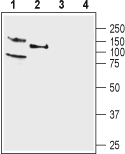Overview
- Peptide (C)DRKTREKGDKGPSD, corresponding to amino acid residues 594-607 of mouse KCNQ4 (Accession Q9JK97). Intracellular, C-terminus.

 Western blot analysis of rat (lanes 1 and 3) and mouse (lanes 2 and 4) brain membranes:1,2. Anti-KCNQ4 Antibody (#APC-164), (1:200).
Western blot analysis of rat (lanes 1 and 3) and mouse (lanes 2 and 4) brain membranes:1,2. Anti-KCNQ4 Antibody (#APC-164), (1:200).
3,4. Anti-KCNQ4 Antibody, preincubated with KCNQ4 Blocking Peptide (#BLP-PC164).
 Expression of KCNQ4 (KV7.4) in rat lateral dorsal raphe nucleusImmunohistochemical staining of perfusion-fixed frozen rat brain sections using Anti-KCNQ4 Antibody (#APC-164), (1:400), followed by biotin-labeled anti-rabbit antibody and streptavidin-ATTO Fluor-594 (red). Staining appears in soma of neuronal profiles (arrows). Nuclei are stained with DAPI (blue).
Expression of KCNQ4 (KV7.4) in rat lateral dorsal raphe nucleusImmunohistochemical staining of perfusion-fixed frozen rat brain sections using Anti-KCNQ4 Antibody (#APC-164), (1:400), followed by biotin-labeled anti-rabbit antibody and streptavidin-ATTO Fluor-594 (red). Staining appears in soma of neuronal profiles (arrows). Nuclei are stained with DAPI (blue).
- Brown, D.A. and Adams, P.R. (1980) Nature 283, 673.
- Coucke, P.J. et al. (1999) Hum. Mol. Genet. 8, 1321.
- Yu, H. et al. (2011) ACS Chem. Neurosci. 2, 572.
- Kubisch, C. et al. (1999) Cell 96, 437.
The KCNQ (KV7) family of channels consists of five members (KCNQ1, KCNQ2, KCNQ3, KCNQ4 and KCNQ5). KCNQ channels commonly display activation at voltages close to neuronal resting membrane potentials and are regulated by G-protein coupled receptor (GPCR) signaling, notably by muscarinic receptors1.
The KCNQ4 (KV7.4) encodes a protein of 695 amino acid residues. The homology with other members of the KCNQ family ranges from 37 to 44% at the amino acid level. KCNQ4 protein contains six domains that span the plasma membrane, and a P-loop domain which forms the K+-selective channel pore. The fourth transmembrane domain contains the voltage sensor, which is responsible for the electrically driven conformational change that leads to channel opening. Functional channels are formed by a tetrameric assembly of KCNQ4 subunits, typically in homotetrameric form, but heterotetrameric co-assembly of different members is allowed2.
KCNQ2-KCNQ5 are predominantly expressed in the peripheral and central nervous system, including hippocampal cells, cortical cells, and dorsal root ganglion3. In addition KCNQ4 is expressed in the heart and in the outer, but not in the inner, sensory hair cells of the cochlea4.
It has been demonstrated that KCNQ4 mutations may be a relatively frequent cause of autosomal dominant hearing loss4.
Application key:
Species reactivity key:
Anti-KCNQ4 Antibody (#APC-164) is a highly specific antibody directed against an epitope of the mouse protein. The antibody can be used in western blot and immunohistochemistry applications. It has been designed to recognize KV7.4 from rat, human, and mouse samples.
Applications
Citations
- Immunohistochemistry of mouse brain sections (1:100). Tested in KCNQ4-/- mice.
Li, L. et al. (2017) Br. J. Pharmacol. 174, 4277.
- Mouse brain lysate.
Li, L. et al. (2017) Br. J. Pharmacol. 174, 4277. - Mouse brain lysate.
Paz, R.M. et al. (2018) Neuropharmacology 137, 309. - Swine artery lysate (1:400).
Goodwill, A.G. et al. (2016) Am. J. Physiol. 310, H693.
- Rat rectal colon sections.
Inagaki, A. et al. (2019) Pflugers Arch. 471, 313. - Mouse brain sections (1:100).
Paz, R.M. et al. (2018) Neuropharmacology 137, 309. - Mouse and human brain sections (1:100).
Li, L. et al. (2017) Br. J. Pharmacol. 174, 4277.
